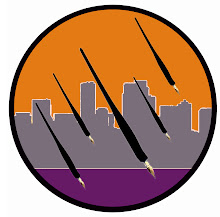In her introduction to City of Illusions she touched on something that I find I'm struggling with in my own WIP.
Villains.
Le Guin's thoughts:
Real villains are rare; and they never, I believe, occur in flocks. Herds of Bad Guys are the death of a novel. Whether they're labelled politically, racially, sexually, by creed, species, or whatever, they just don't work. The Shing are the least convincing lot of people I ever wrote.In the series of integrated stories I am finishing up, I've got some baddies that I'm just not all that satisfied with. They are called Thority (a "what if" spinning out of a world in which the transit authority ends up as the sole organization, and having access to resources they can wield quite a bit of power.)
As the stories have evolved, I've found myself needing to explain why they are bad. I didn't want it to just be because Power Corrupts. Maybe that impulse was a good one, a step away from the grey wash and the Herds of Bad Guys that Le Guin regrets in her own writing. If you give the bad guys a story, rather than just having them fit a category, maybe they will be more interesting. More real.
But the story I have told has explained away their moral culpability. They've got soft-wiring that's gone glitchy. And right now it feels again that I'm taking a step back toward category-badness. I didn't set out to write a zombie story, but in way I think Thority have ended up fitting into that trope.
So maybe Thority really aren't the villains in my stories. Maybe no-one in them is. Maybe all my characters are each doing the best they can with what they have, even if that best sometimes results in a whole lot of pain.


4 comments:
Nice post. Now you are making me think more about the Vampires in my novel. I see them as obstacles for my characters to overcome, but more than that. With zombies and vampires I think there is always the risk of the characters being "infected" and turning into the monsters themselves. This sort of thing always implies to me some sort of "fear of society" or "fear of assimilation" kind of idea.... Where (once bitten) the unique character is lost to become one of the masses, a mindless horror or drone. I know I always appreciate a strong villain in a story that has his/her own personality and desires. One problem I see with many a movie lately is the hordes of CGI monsters for the protagonists to splatter. Often boring. Where one really strong, smart, unique villain makes for a much better story.
Great post, Lisa. I think you're right, no one is the villain of their own story, but I think Mark has a good point too. There's levels to villains, with different intents/purposes for different baddies. Although it's true it's hard to maintain the more broad motivation/threats of a large crowd as compared to a singular purpose of a single villain. So I guess I don't think a crowd is a bad thing as long as there are some individuals too.
The monsters without vs the monsters within.
Yup - I agree with both Mark and Jon. I guess what I'm starting to get clearer on is that I think the crowd of baddies isn't so much the villain of any story, but the background within which the main characters act (and perhaps some one or few of those characters are villains, depending on the story.) So groups can't be convincing villains on their own. But yes, there clearly can be a role for the crowd-of-baddies in story-telling.
That's how I always thought of the zombies in my book: Constant, mobile and dangerous obstacles the characters have to deal with.
Post a Comment